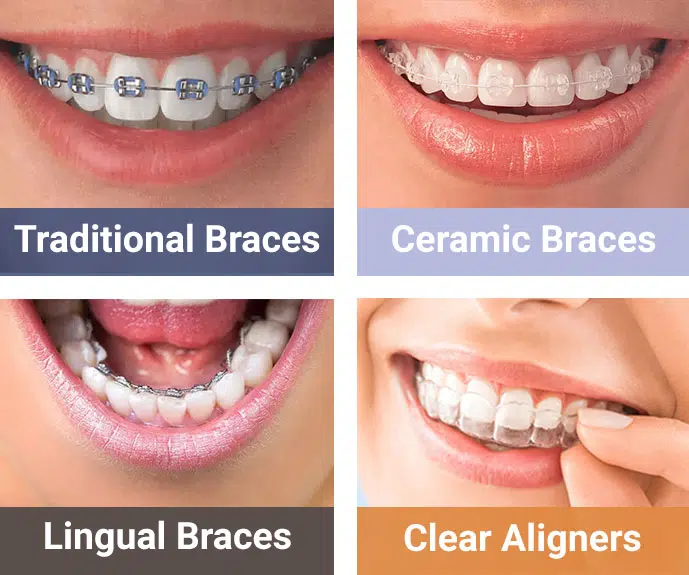Braces, a common solution for correcting teeth alignment issues, come in various forms. Orthodontists use high-grade stainless steel to create traditional metal braces. They attach these braces to the front of teeth, and this design has been in use for decades.
Ceramic braces, while similar in structure to their metal counterparts. Blend more with natural teeth color for a less conspicuous look. Lingual braces, fixed to the back of teeth, remain almost hidden from view.
A Revolutionary Step in Orthodontics
In recent years, braces have revolutionized orthodontics. Clear, custom-made aligners, like Invisalign, are undetectable. You can remove them for eating and cleaning.
They’re replaced over time to shift teeth into desired positions. This modern solution addresses many concerns associated with traditional braces, aesthetics, and discomfort. It makes a popular choice, especially among adults.
Invisible(unseeable) Braces
Though rarely mentioned, invisible braces are a type of braces. The invisible differs from traditional metal or ceramic braces. Their clear, plastic construction makes them undetectable. Orthodontists custom-fit them to the user’s teeth, and you can remove them for eating and cleaning.
This topic laid the foundation for a more detailed discussion. It covers the benefits, processes, and considerations when choosing invisible braces.
Square Braces ( [ ] )
Despite the name, square braces, also known as ‘box brackets’ or ‘brackets,’ see more use in math and computer science than in orthodontics.
In math, they show a closed interval or a floor function. In computer programming, programmers use square braces for arrays or lists. They’re a bracket for organizing code and data in programs.
Round Braces ( ( ) )
Round braces, known as traditional braces, have been a staple in orthodontic treatment for years. These braces, made of stainless steel, consist of small, round brackets adhered to the front surface of the teeth.
A thin archwire connects these brackets and applies pressure to the teeth, guiding them into proper alignment. Round braces serve more than straightening teeth. They are crucial in correcting bite issues, improving oral function, and enhancing dental health.
The Importance of Braces
Braces play a crucial role in oral health beyond the cosmetic benefit of straight teeth. When your teeth are not straight, it can cause issues like trouble cleaning them, leading to more cavities and gum problems.
Braces fix these problems with your bite, ensuring your teeth don’t wear down and preventing issues like jaw pain and headaches. Also, straight teeth help with better digestion by making it easier to chew your food.
Braces can also improve speech, as misaligned teeth can impact the clarity of certain sounds. So, investing in braces is not only about a beautiful smile but also about ensuring optimal oral health and well-being.
Comparing Invisible to Traditional Braces
When deciding whether to go for invisible braces or traditional braces, it can be a difficult decision to make. There are several key factors to consider:
Appearance
The primary difference lies in their appearance. Traditional braces, made of metal or ceramic, are visible. They can lead to self-consciousness in some individuals. So, invisible are undetectable as they are clear and blend well with the teeth.
Comfort and Convenience
With comfort and convenience, the invisible have an edge. You can remove clear aligners when you eat, drink, and clean your teeth. Fixed traditional braces can make these activities more challenging. Invisible also tend to cause less irritation to the mouth compared to the metal wires and brackets of traditional braces.
Effective Option
When treating more complex dental issues, traditional braces may be the more effective option. They can correct severe crowding, misalignment, and bite issues more than invisible. Additionally, treatment with traditional braces is usually less expensive than with invisible aligners.
Finally, commitment to treatment can also be a deciding factor. Both treatments need regular visits to the orthodontist. Still, the invisible need patients to take on a high level of responsibility. They must wear aligners for a specified number of hours each day.
Conclusion
Braces, in their mixed forms, remain a popular and effective solution for correcting teeth alignment issues. Traditional braces, with their long history and proven results, continue to be a reliable option for many individuals. But, introducing braces has made orthodontic treatment more accessible and less invasive.
Choosing between invisible or traditional braces depends on individual needs and preferences. Still, both options can lead to a beautiful smile and improved oral health. So whether it’s traditional metal braces or modern clear aligners. Everyone can find a suitable solution for achieving straighter teeth. Braces are not an aesthetic tool but an essential component of maintaining optimal oral health.
